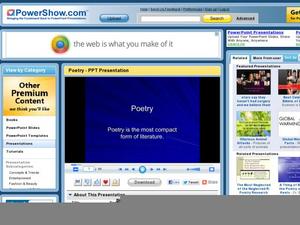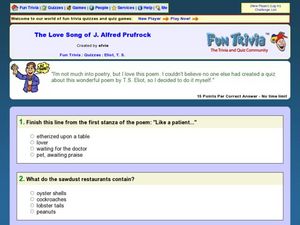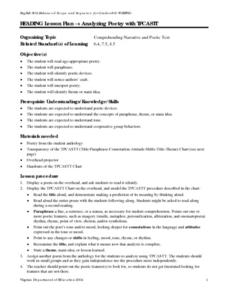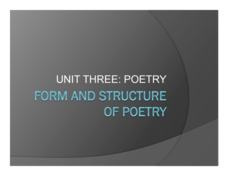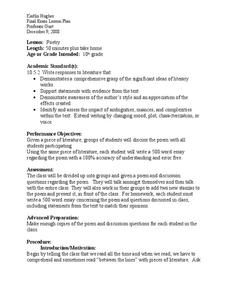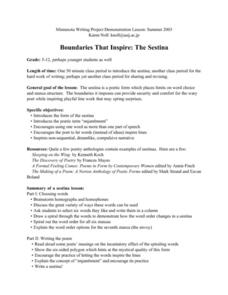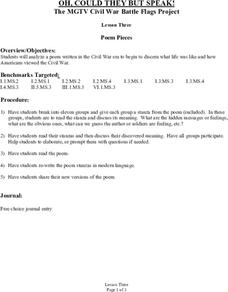Curated OER
Poetry - Stanzas - I Am Poem
Reinforce the concept that many poems are organized into stanzas, each of which has the same number of lines. The provided worksheet template asks young poets to craft three stanzas that all begin with the same line and have the...
National Park Service
The Poet's Toolbox
If you need a lesson plan for your poetry unit, use two poems by Henry Wadsworth Longfellow ("Rain in Summer" and "The Slave in the Dismal Swamp") and a resource on Elements of Poetry. The lesson plan guides you through...
Curated OER
Poetry: The Most Compact Form of Literature
Introducing or need to review literary devices and terms for a study of poetry? Though text heavy, the explanations and examples of key poetic devices will provide learners with the vocabulary they need to discuss and craft poems.
Curated OER
War Literature
Working in groups, young historians review a war poem written by Stephen Crane. After reviewing the poem, they present an oral interpretation of the poem and hold a panel discussion about their analysis. The panel is made up of five or...
Curated OER
Poetic Elements
Poetry is all about sound and rhythm. The sound of the words, the rhythm of the lines, and the emotional atmosphere created by these elements and the literary devices poets use, compress whole stories into a few stanzas. The specialized...
Curated OER
Reading and Responding: Lesson 9
Follow this lesson, which is written more like a script, to practice reading a poem with your class. Pupils read "The Road Not Taken" and respond to five multiple choice questions on a provided worksheet. The plan leads you through a...
Curated OER
Poetry Project
Choosing a poet or a theme, eighth graders conduct research in the world of poetry. They conduct Internet research and select five poems that fit their poet or theme, and create a seven slide PowerPoint presentation on their selected...
Curated OER
The Love Song of J. Alfred Prufrock quiz
Delve into the mysterious lines of T.S. Eliot's The Love Song of J. Alfred Prufrock. Focusing on simple recall of the poem, this quiz can then spark discussion about the odd comparisons and allusions within the lines. A simple quiz that...
Curated OER
Analyzing Poetry with TPCASTT
Middle schoolers read a poem and complete a TPCASTT chart. They make a prediction about the title (T) , paraphrase each line (P), identify poetic devices and nuances (C-connotation), explore mood and tone (A-attitude), point out shifts...
Curated OER
The Raven
After a close reading of Edgar Allan Poe's "The Raven" individuals copy the rhythm and rhyme scheme and rewrite the final stanzas of the poem.
Springfield Public Schools District 186
Form and Structure of Poetry
If anyone suffers from metrophobia—the fear of poetry—the PowerPoint on the elements of poetry may help alleviate their worries. The presentation introduces learners to poetic elements, including simile, metaphor, and personification....
BPE
Teacher Guide for Faster Passage: "Sympathy" and "Caged Bird" Poetry
Prepare class members for formative assessments of student thinking in reading (FAST-R) with a resource that compares Paul Laurence Dunbar's "Sympathy" and Maya Angelou's "Caged Bird." Readers respond to 10 multiple choice questions and...
Curated OER
Writing Poems Worksheet
In this writing poems worksheet, students record 10 nouns, then write 2 or 3 verbs next to each noun, and finally write a simile or metaphor that matches the noun and verbs in that row. Students then organize these lines into stanzas to...
Curated OER
More Spring Poems: The Bee And The Flower
In this literature worksheet, students read and discuss the poem "The Bee And The Flower," color the picture, underline or circle the rhyming words and then print the rhyming words on pages two through four on the lines provided.
Curated OER
Poetry
Tenth graders write a poem. In this poetry lesson, 10th graders read the poem The Road Not Taken written by Robert Frost, answer discussion questions, add new stanzas to the poem and share them with the class.
College of the Canyons
Free Verse
Free verse poetry is often regarded as poetry without structure, but in reality, it is a poetic form that adheres to its own poet's thought and breath patterns. Delve into the rules and famous examples of free-verse poetry with a short...
Curated OER
Video Poetry
Learners analyze a poem to find meaning by breaking it into scenes and supporting the text with appropriate images and sounds. They use Frames to create their video poem. Once students have an image, place them all into one folder. ...
Curated OER
Boundaries That Inspire: The Sestina
Students study the poetic term "enjambment". They use one word as more than one part of speech and let words (instead of ideas) inspire lines and non-sequential, dreamlike, compulsive narrative.
Curated OER
Adjectives in Poetry
Fourth graders create a poem using adjectives. In this poetry lesson, 4th graders read the story Akiak and identify the adjectives. Students create a stanza for Akiak.
Curated OER
Poetry in Motion
Students create individual poems containing varied line lengths, punctuation, and rhythm, and explain how each contributes to overall effect of the poem.
Curated OER
Project 7a B-b-b-Ballad!
In this ballad composition worksheet, students compose a ballad in any key as they write a 12 line rhyming poem and continue to follow the other 6 steps to create their original ballad.
Curated OER
Snowy Evening Poetry for ESL (Elementary, Literature)
Students read Robert Frost's Stopping by the Woods on a Snowy Evening, illustrated by Susan Jeffers (2001). This is a wonderful book with beautiful illustrations that go with each line of the poem.
Curated OER
Lesson Three: Poem Pieces
Students read and analyze stanzas of Civil War poem, The Flags of Michigan, to get perspective on what life was like and how Americans viewed Civil War, rewrite stanzas in modern language, and share new versions of poem with classmates.
Curated OER
Poetry: Ten Little Schoolchildren
Students analyze a sequential, story poem and put the stanzas in order. They identify repeated verses and answer questions about the poem. They identify examples of alliteration. Finally, they make their own poem in a given pattern.




